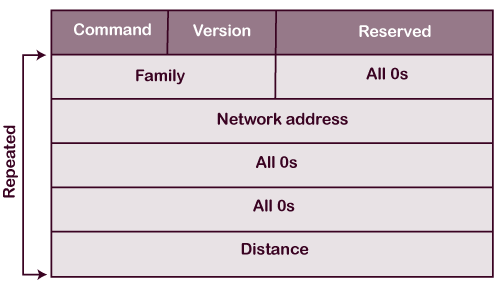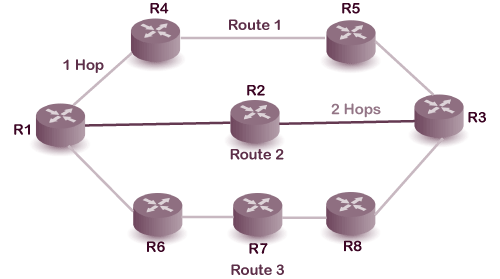RIP Message Format
-
Command: It is an 8-bit field that is used for request or reply. The value of the request is 1, and the value of the reply is 2.
-
Version: Here, version means that which version of the protocol we are using. Suppose we are using the protocol of version1, then we put the 1 in this field.
-
Reserved: This is a reserved field, so it is filled with zeroes.
-
Family: Is a 16-bit field. If you are using TCP/IP family, you would put a 2 in this field.
-
Network Address: It is defined as 14 bytes field. If we use the IPv4 version, then we use 4 bytes, and the other 10 bytes are all zeroes.
-
Distance: The distance field specifies the hop count, i.e., the number of hops used to reach the destination.
RIP Message Format Size Calculation
-
Each message contains a command and a version number and can contain entries for up to 25 routes.
-
Each route entry includes an address family identifier, the IP address reachable by the route, and the hop count for the route.
-
Can contain a maximum of 25 route entries,
-
If a router must send an update with more than 25 entries, multiple RIP messages must be produced.
-
Note that the initial portion,
-
Therefore the maximum message size

RIP Scenario
Scenario
You have been tasked to write a script that calculates the amount of data transmitted for RIP Routing Tables.
You have written a script that and test for RIP Routing Table that has 38 routes, you have been this is script needs to also needs to calculate the total data transmitted over the last 24 hours, remembering that RIP updates every 30 seconds.
-
-
-
-
(25 routes)
(13 routes)
RIP Routing tables: Timings
So a state of convergence is achieved once all routing protocol-specific information has been distributed to all routers participating in the routing protocol process.
The following timers are used to update the routing table:
-
RIP update timer : 30 sec
- The routers configured with RIP send their updates to all the neighbouring routers every 30 seconds.
-
RIP Invalid timer : 180 sec
- which means that if the router is disconnected from the network or some link goes down, then the neighbour router will wait for 180 seconds to take the update. If it does not receive the update , then it will mark the particular route as not reachable.
- RIP Flush timer : 240 sec
- if the router does not receive the update then the neighbour route will remove that particular route from the routing table

RIP routing tables: layout
The columns Network destination and Netmask together describe the Network identifier.
The Gateway column contains the same information as the Next hop, i.e. it points to the gateway through which the network can be reached.
The Interface indicates what locally available interface is responsible for reaching the gateway.
Finally, the Metric indicates the associated cost of using the indicated route. This is useful for determining the efficiency of a certain route from two points in a network.
RIP pt 2
-
When the router sends the packet to the network segment, then it is counted as a single hop.
-
Router 1 forwards the packet to the Router 2 then it will count as 1 hop count.
-
when the Router 2 forwards the packet to the Router 3 then it will count as 2 hop count
-
when the Router 3 forwards the packet to Router 4, it will count as 3 hop count
RIP Examples
If there are 8 routers in a network, where Router 1 wants to send the data to Router 3. RIP will choose the route which has the least number of hops:
-
Route 2 -> 2 hops
-
Route 1 -> 3 hops
-
Route 3 -> 4 hops
RIP Examples PT 2 (Load Balancing)
Suppose R1 wants to send the data to R4, there are two possible routes:
-
R1, R2, R3, R4 -> 3 hops
-
R1, R5 ,R6, R4 -> 3 hops
Therefore, RIP will send the data to both the routes simultaneously. RIP manages the load balancing, and data reach the destination a bit faster.